Kato Interior Passenger Car Lights
While some Kato passenger trains have factory-installed interior lights, and others make no provision for lighting, most of Kato’s trains made in the last ten years use a standardized interior lighting system. This consists of a light unit and some brass strips to connect it to pre-installed electrical pickups, a transparent plastic diffuser to spread the light evenly the length of a car, and a strip of mirrored tape that attaches to the roof of the car. Some of the earliest models (the Passenger Car Lighting Kit, model 11-201) used a different type of electrical pickup, but for later ones (starting with the New Passenger Car Lighting Kit, model 11-204 and the six-pack set 11-206) the pickups were standardized too. When these were introduced in 2004 white LEDs were still rather expensive, so Kato provided both the 11-204 set for 400 yen, and an Interior Light Kit with White LED (model 11-209) for 700 yen that was identical except for the light unit. These were also available in six-packs at an effective price about 16% less per unit.
These original kits had a lightboard separate from the white bracket that held it in place (and which needed to be assembled along with a small strip of reflector tape on the underside of the lightboard). Installation of one of these is covered on my DCC Ready EMU page. Note that an orange filter is also included, which is used if you want a yellower tint to the light to represent older trains with incandescent lighting rather than a new one with fluorescent lights.
LEDs use less power, and produce less heat, making them superior for applications with limited ventilation and/or continued use. DCC in particular provides high sustained voltages, which could lead to overheating with bulbs. Kato has reportedly said that their LED lighting sets may be used directly on DCC. They also sell a DCC decoder (the FR11, which takes the form of a replacement for the lightboard) which allows the lights to be turned on and off, although as one US$17 decoder is needed per car this gets very expensive. Given that the service life of a LED is measured in thousands of hours, it’s simpler to just omit the decoder and leave the lights on when the car is on the track, which is what I do.
Note: Kato’s comment about use on DCC may assume their DCC system, which is essentially a Digitrax Zephyr with a 13.8V output to the track. Many DCC systems designed for HO scale train put out 16, 18 or even 23V to the track, and these are potentially problematic for LEDs that assume a lower voltage (it’s not clear that using Kato’s FR11 would change that). Users of interior lighting should probably be sensitive to the voltage used by their DCC system.
Version 2 LED Lighting
In late 2011, Kato introduced a new “version 2” lighting set, model 11-211 for 720 yen (and a six-pack set, 11-212, for 3600 yen, about a 17% savings, US$46.24 per set before shipping, or $7.71 each). These eliminate the reflector strip, have a new pre-assembled lightboard/bracket unit, and feature a redesigned diffractor. Also, while the power pickup seems unchanged, the lights suffer much less from the flickering due to intermittent contact that plagued the original sets. However, I’ve only installed these in a new train so far, so this may be a feature of the train rather than the lights. Kato didn’t change the design of the power pickups or lightboard bracket, so the FR11 can still be used in place of the new DC lightboard, gaining the advantages of the new diffuser design.
And, as we’ll see, these new lighting sets are required for newer Kato models (unless you want to perform some minor cutting of plastic on the model) but should be compatible with any older model that took the LED lighting sets.
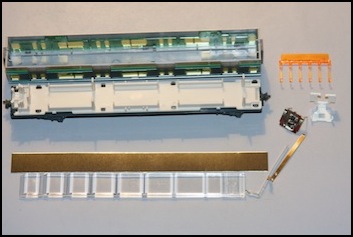
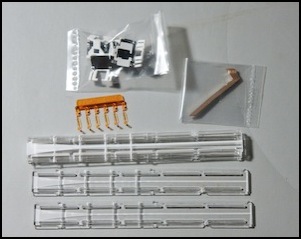
Left: Kato original LED lighting kit (11-209) with car, and right new “version 2” LED lighting (six-pack set, 11-212)
The diffuser strip is segmented, and can fit into shorter cars by snapping off one or more segments. Full-size, it fits Kato’s typical EMU car, and with one segment removed fits into cab cars behind the cab, which has factory-installed lighting for the head and tail lights and destination board(s). But the new board has two other differences.
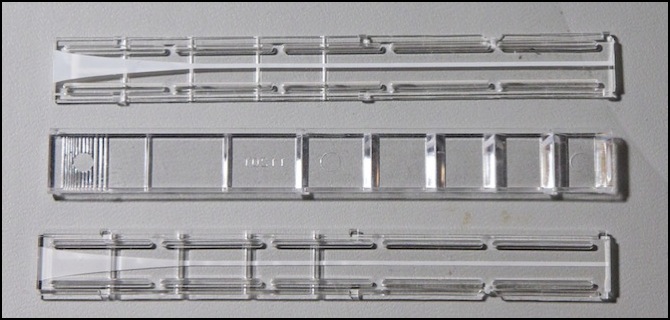
Old (center) and new (top and bottom) lighting diffuser strips
First, the old board was solid and rested atop four pillars in the car (part of the floor assembly, see photos below). The new board is slotted, and snaps down onto the tops of redesigned pillars in newer cars, as the photo below shows. This might seem like a minor change, but it holds the diffuser more carefully in alignment with the LED, so there is less chance that it will move out of place as the car is reassembled (or later), reducing the effectiveness of the lighting.
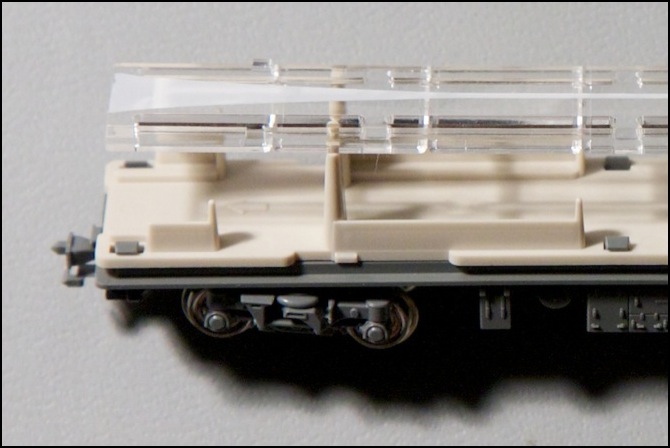
Diffuser snapped onto support pillars
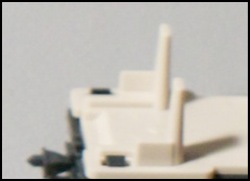
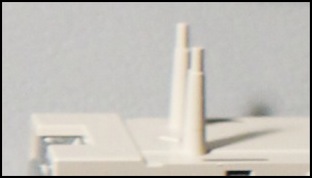
L: old-style solid posts, R: new-style tapered posts
The new diffuser assumes the use of a new form of support inside the car. The new support is 2mm taller than the old one, and tapers to a circular pin where the old one ended, with the top of the pin being flush with the top of the diffuser. This holds the diffuser in place better, but it prevents the use of older lighting kits (unless you want to cut the pin off). However, it looks like it will be possible to install the new lighting kit in cars that were designed to take the older one. The electrical pickups and lighting mounting bracket are identical, and the new diffuser can rest atop the older short posts the same way the old diffuser did (it is the same length, width and thickness).
Second, as seen above, the new diffuser has a white design printed on one side (the top). This widens out at the end away from the LED. I’d first thought this should go at the LED ends, but the instructions show it at the far end, and a quick test revealed a more even lighting when it was away from the LED; apparently it serves to reflect more light downwards at the far end of the car, and makes the lighting more even. You still get some hot-spotting, particularly if you leave a gap between the lightboard and the diffuser, but overall the lighting is much more even, and appears to be as bright as the old one.
Because the lightboard/bracket assembly comes pre-assembled, this is an easier set to install: just open the car, slide in the pickups, insert the lightboard, and snap the diffuser in place, then reassemble the car. That assumes you don’t need to use the yellow filter, as installing it means separating the lightboard from the bracket and reassembling it, which is much more work.
When I added a set of these to my ten-car Tōkyō Metro 10000 Series train, total power draw on 12V DCC for a stationary train was 150 mA (including the cab lights). That means that power per light is around 12 to 15 mA, somewhat high for an SMD LED, but not unreasonable for a bright-white one.
At present (January 2012) the new lighting sets are only available from stores in Japan. However the box is bilingual and marked for Kato U.S.A. in English and includes a Japanese/English instruction sheet, so it is clear these will show up over here eventually. Kato seems to be selling these as fast as they make them right now, and they’re constantly sold out, so we’ll probably have to wait until the Japanese market saturates before we’ll see them here.




